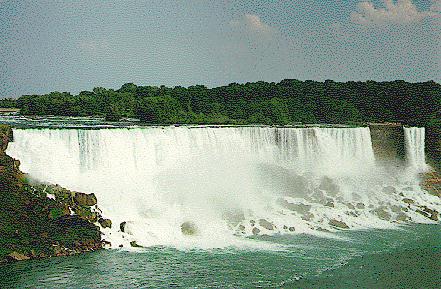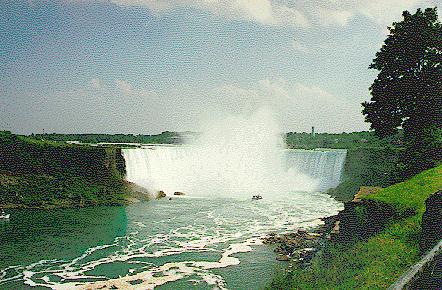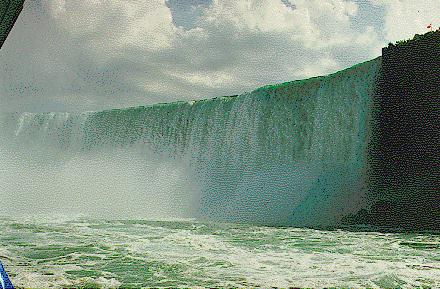

|
Niagara Falls |
Overview: Impressive, but very popular. Location: Niagara Falls, NY and Niagara Falls, Ontario Stream : Niagara River Height : 175 feet Finding : Simple, but requires city driving. Access : Wheelchair accessible. Swimming: No Basking : Yes. Plenty of benches in the park(s). Legal : Open to the public.
All pictures on this page were actually taken in the summer of 1996 by my good friend, John Bedard. I give many thanks to John for his willingness to share his excellent photographs!
My daughter Hillary and I took a trip to visit these famous waterfalls. Although not in New England, Niagara Falls are not that far from where I live, and I felt the need to see them. I've been to Niagara Falls before -- more than once -- but not since starting my work on this web site. My daughter had never seen them before.
 As measured by the volume of water that flows over the falls, Niagara Falls is the
largest waterfall in the world. The Niagara River carries 1.6 million (US) gallons per
second. However, these days between 50% and 75% of that water is diverted to power
turbines to generate electricity. As much as 3,000 megawatts of electricty is generated in
this way. Consequently there is much less water flowing over the falls today than in years
past. Nevertheless it is still an impressive sight.
As measured by the volume of water that flows over the falls, Niagara Falls is the
largest waterfall in the world. The Niagara River carries 1.6 million (US) gallons per
second. However, these days between 50% and 75% of that water is diverted to power
turbines to generate electricity. As much as 3,000 megawatts of electricty is generated in
this way. Consequently there is much less water flowing over the falls today than in years
past. Nevertheless it is still an impressive sight.
The height of Niagara Falls is not world class. Although I don't normally see waterfalls with a 175 foot single vertical drop, there are many waterfalls in the world that are far higher. In fact, Arethusa Falls in the White Mountains of New Hampshire and Taughannock Falls in the Finger Lakes region of New York both boast single vertical drops in excess of 200 feet. Niagara does not even make the chart when compared to the truely high waterfalls of the world (Angel Falls in Venezuela is the highest at an astonishing 3281 feet).
Hillary and I arrived in Niagara Falls, Ontario in the late afternoon on Monday. After securing a place to stay the night we walked down to the river to see the falls. Niagara is a type of urban waterfall. Although the falls are natural, they exist between two small cities and are thus surrounded by people and by the works of humanity. We approached the falls on city streets, crossing roads on walk signals and dodging cars. In addition, the falls have attracted a huge tourist market complete with gift shops, tours, boat rides, and many other things. Niagara Falls is about as far from a wilderness waterfall as it is possible to get.
Yet the sheer power of this massive waterfall overwhelmed all of the tourist shops. Despite the masses of people, Niagara is a wild waterfall! As Hillary and I walked down the city streets toward the falls, I noticed a distinctive smell in the air. It was the smell of freshly vaporized water. It was the smell of a waterfall. I am used to smelling that smell in the deep forest glades that surround a mountain stream. Yet there it was on the city streets of Niagara Falls, Ontario: fully half a mile away from the waterfall itself!
The Canadians have created a very nice park along the edge of the gorge below the falls. You can walk alongside the gorge (well fenced off, of course) on paved walkways among gardens and lawns and well groomed trees. In addition, there are nicely placed overlooks to make viewing the falls easier. Upstream from the falls is a large parking area from which you can take a shuttle bus to points along the river. All in all it was a very pleasent spot. It was also a very popular one. The whole time Hillary and I were there, the place was packed with people and at the overlooks people crowded against the fence shoulder to shoulder. It was profound testimony to the fascination we all seem to have with waterfalls.
Niagara Falls themselves come in two parts. The American Falls flow over the edge of the gorge on the American side directly across the river from the Canadian park I described above. The American Falls crash down onto a large pile of imposing rocks. These rocks reduce the free fall height of the American falls considerably, but they also add quite a bit of interest to the falls.
 A bit farther upstream is the larger Horseshoe Falls. These falls are slightly lower
than the American Falls and they carry 90% of the water that flows over Niagara (although
that fact is not evident from looking at the falls: both of them seem quite impressive).
The Horseshoe Falls do not cut straight across the river but bend in a giant horseshoe
shape. The lip of the falls is 2200 feet across with the river flowing nearly 40 mph as it
spills over the edge. When the water crashes into the pool below a cloud of mist is forced
into the air well above the height of the falls themselves -- perhaps extended as much as
300 feet above the lower level of the river. This is not something you see everyday.
A bit farther upstream is the larger Horseshoe Falls. These falls are slightly lower
than the American Falls and they carry 90% of the water that flows over Niagara (although
that fact is not evident from looking at the falls: both of them seem quite impressive).
The Horseshoe Falls do not cut straight across the river but bend in a giant horseshoe
shape. The lip of the falls is 2200 feet across with the river flowing nearly 40 mph as it
spills over the edge. When the water crashes into the pool below a cloud of mist is forced
into the air well above the height of the falls themselves -- perhaps extended as much as
300 feet above the lower level of the river. This is not something you see everyday.
The fenced walks bring you right up to the lip of the Horseshoe where you can stand and look at the water rushing over the edge only a few feet away. I was impressed by the speed and power of the water and by its depth. It appeared to me that the river was still several feet deep even at the lip of the waterfall. This was no small stream trickling down a rock face.
Hillary and I did take in a few of the attractions of the area. We visited the falls at night and watched as different colored lights were shined on them. It was a bit odd looking, but neat in a way. The next day, we rode to the top of the Skylon tower 520 feet above the city to view the falls from above. It was interesting to see them all in one sweeping view, but it also made it clear how low Niagara really is. A truely high waterfall would be taller than the Skylon tower.
Finally we took an elevator down to a platform at the base of the Horseshoe Falls. We were given cheap plastic raincoats to wear as we stood below the falls and gawked up at it. It was good that we had the raincoats. The mist was so thick that it quickly soaked everything. Even with the raincoats we got rather wet. From there Hillary and I followed an underground tunnel to a couple of portals that looked out from behind the falls. The view was somewhat uninteresting. It was just a sheet of white water. What was more interesting, to me, was the noise. The very walls of the tunnel seemed to shaking with a powerful throbbing as if some great engine was laboring nearby.
Hillary and I decided not to take the boat ride up to the falls. The Maid of the Mist takes people to the foot of the Horseshoe and it looked a bit disconcerting to my daughter. I could understand that.
Niagara is interesting from a geological point of view. The falls are only about 15,000 years old. They came into existence at the end of the last ice age. At that time they were much farther downstream than they are today. During the last 15,000 years they have cut back into the riverbed 7 miles to reach their current location. Downstream from the falls is a long, deep gorge. Until recently the falls were cutting back at the rate of 3 feet per year. However, in an effort to stablize the falls (humans don't like natural changes it seems), some modifications were made to the rock face over which the falls pour. Currently they are cutting back at the rate of only 1 foot every 10 years.
It is in the nature of waterfalls to cut into their channel. What makes Niagara a bit unusual is the fact that the falls have remained vertical despite 15,000 years of erosion. Ordinarly falls tend to level themselves out leaving behind only a gorge. However, the rock at Niagara is such that a hard layer rests on top of much softer rock. The backwash from the falls erodes the soft rock away leaving the hard layer on top to extend out from the retreating cliff face. Eventually a chunk of the hard layer breaks off and the falls move back a few feet. The process then repeats itself. The hard rock on top inhibits the normal leveling process and keeps the falls vertical despite the high erosion rate.
The appearance of Niagara Falls has changed over recorded history. My parents have photographs of the American Falls taken in 1952 that show distinct differences from its current appearance [I will try to get these photographs and scan them in for you to see what I mean]. Apparently if left to its own devices, the Horseshoe Falls (the faster moving of the two) would cut off the American Falls and dry it up in only about 100 more years. It is rare to see such geologic changes in such a short time. I guess that's what 1.6 million gallons of water per second can do for you!
If you are into waterfalls, you should try to see Niagara at some time in your life. It is certainly worth visiting.
There are many Niagara links returned by the web search engines. If you happen to know of a definitive Niagara link, let me know and I'll add it here. For now, this Guide to Niagara Falls seems like as good a place to start as any. Also Scott Ensminger has a nice page of information on Niagara Falls. Finally, check out Thunder Alley, a site dedicated to Niagara Falls education and tourism.
Return to the list of waterfalls.